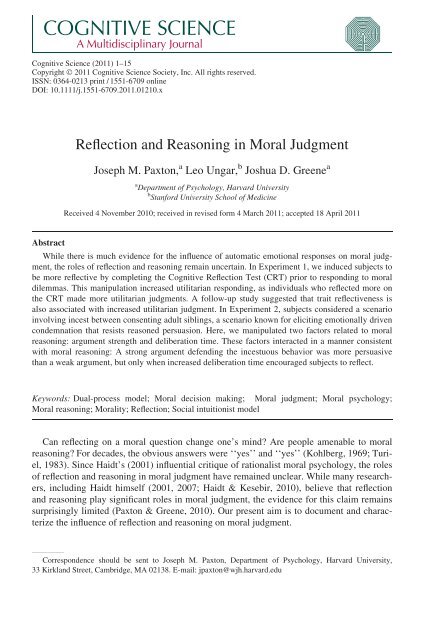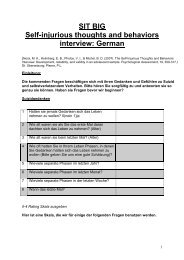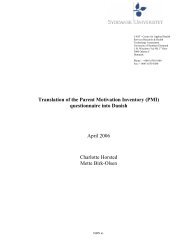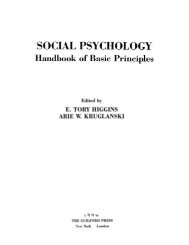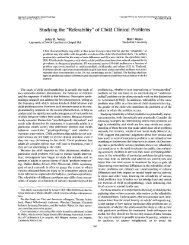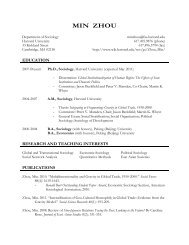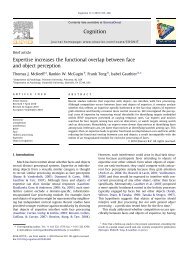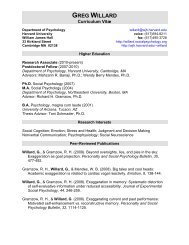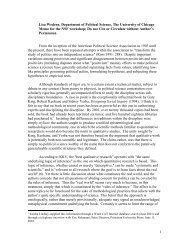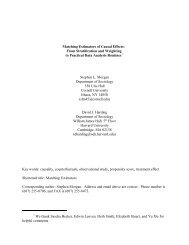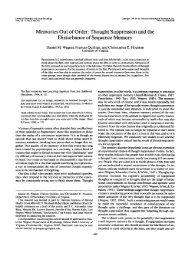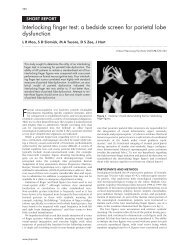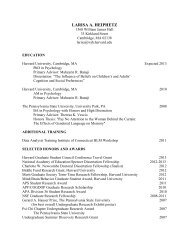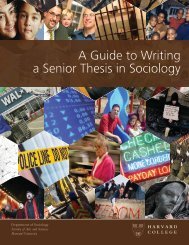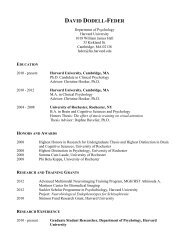Reflection and Reasoning in Moral Judgment - WJH Home Page ...
Reflection and Reasoning in Moral Judgment - WJH Home Page ...
Reflection and Reasoning in Moral Judgment - WJH Home Page ...
Create successful ePaper yourself
Turn your PDF publications into a flip-book with our unique Google optimized e-Paper software.
Cognitive Science (2011) 1–15<br />
Copyright Ó 2011 Cognitive Science Society, Inc. All rights reserved.<br />
ISSN: 0364-0213 pr<strong>in</strong>t / 1551-6709 onl<strong>in</strong>e<br />
DOI: 10.1111/j.1551-6709.2011.01210.x<br />
Abstract<br />
<strong>Reflection</strong> <strong>and</strong> <strong>Reason<strong>in</strong>g</strong> <strong>in</strong> <strong>Moral</strong> <strong>Judgment</strong><br />
Joseph M. Paxton, a Leo Ungar, b Joshua D. Greene a<br />
a Department of Psychology, Harvard University<br />
b Stanford University School of Medic<strong>in</strong>e<br />
Received 4 November 2010; received <strong>in</strong> revised form 4 March 2011; accepted 18 April 2011<br />
While there is much evidence for the <strong>in</strong>fluence of automatic emotional responses on moral judgment,<br />
the roles of reflection <strong>and</strong> reason<strong>in</strong>g rema<strong>in</strong> uncerta<strong>in</strong>. In Experiment 1, we <strong>in</strong>duced subjects to<br />
be more reflective by complet<strong>in</strong>g the Cognitive <strong>Reflection</strong> Test (CRT) prior to respond<strong>in</strong>g to moral<br />
dilemmas. This manipulation <strong>in</strong>creased utilitarian respond<strong>in</strong>g, as <strong>in</strong>dividuals who reflected more on<br />
the CRT made more utilitarian judgments. A follow-up study suggested that trait reflectiveness is<br />
also associated with <strong>in</strong>creased utilitarian judgment. In Experiment 2, subjects considered a scenario<br />
<strong>in</strong>volv<strong>in</strong>g <strong>in</strong>cest between consent<strong>in</strong>g adult sibl<strong>in</strong>gs, a scenario known for elicit<strong>in</strong>g emotionally driven<br />
condemnation that resists reasoned persuasion. Here, we manipulated two factors related to moral<br />
reason<strong>in</strong>g: argument strength <strong>and</strong> deliberation time. These factors <strong>in</strong>teracted <strong>in</strong> a manner consistent<br />
with moral reason<strong>in</strong>g: A strong argument defend<strong>in</strong>g the <strong>in</strong>cestuous behavior was more persuasive<br />
than a weak argument, but only when <strong>in</strong>creased deliberation time encouraged subjects to reflect.<br />
Keywords: Dual-process model; <strong>Moral</strong> decision mak<strong>in</strong>g; <strong>Moral</strong> judgment; <strong>Moral</strong> psychology;<br />
<strong>Moral</strong> reason<strong>in</strong>g; <strong>Moral</strong>ity; <strong>Reflection</strong>; Social <strong>in</strong>tuitionist model<br />
Can reflect<strong>in</strong>g on a moral question change one’s m<strong>in</strong>d? Are people amenable to moral<br />
reason<strong>in</strong>g? For decades, the obvious answers were ‘‘yes’’ <strong>and</strong> ‘‘yes’’ (Kohlberg, 1969; Turiel,<br />
1983). S<strong>in</strong>ce Haidt’s (2001) <strong>in</strong>fluential critique of rationalist moral psychology, the roles<br />
of reflection <strong>and</strong> reason<strong>in</strong>g <strong>in</strong> moral judgment have rema<strong>in</strong>ed unclear. While many researchers,<br />
<strong>in</strong>clud<strong>in</strong>g Haidt himself (2001, 2007; Haidt & Kesebir, 2010), believe that reflection<br />
<strong>and</strong> reason<strong>in</strong>g play significant roles <strong>in</strong> moral judgment, the evidence for this claim rema<strong>in</strong>s<br />
surpris<strong>in</strong>gly limited (Paxton & Greene, 2010). Our present aim is to document <strong>and</strong> characterize<br />
the <strong>in</strong>fluence of reflection <strong>and</strong> reason<strong>in</strong>g on moral judgment.<br />
Correspondence should be sent to Joseph M. Paxton, Department of Psychology, Harvard University,<br />
33 Kirkl<strong>and</strong> Street, Cambridge, MA 02138. E-mail: jpaxton@wjh.harvard.edu
2 J. M. Paxton, L. Ungar, J. D. Greene ⁄ Cognitive Science (2011)<br />
Accord<strong>in</strong>g to Haidt’s Social Intuitionist Model (SIM), moral judgment is predom<strong>in</strong>antly<br />
<strong>in</strong>tuitive, driven primarily by automatic emotional responses that are effortless <strong>and</strong> produced<br />
by unconscious processes. Numerous studies now attest to the <strong>in</strong>fluence of automatic emotional<br />
responses on moral judgment (e.g., Greene, Sommerville, Nystrom, Darley, & Cohen,<br />
2001; Koenigs et al., 2007; Schnall, Benton, & Harvey, 2008; Valdesolo & DeSteno, 2006;<br />
Wheatley & Haidt, 2005). As noted above, the roles of reflection <strong>and</strong> reason<strong>in</strong>g—here<br />
understood as processes that are conscious, controlled, <strong>and</strong> often temporally extended<br />
(Haidt, 2001)—rema<strong>in</strong> far less clear.<br />
Accord<strong>in</strong>g to the SIM, reflection <strong>and</strong> reason<strong>in</strong>g typically serve to rationalize moral judgments<br />
that were previously made <strong>in</strong>tuitively. The SIM also posits that one may occasionally<br />
<strong>in</strong>fluence one’s own judgments directly through reason<strong>in</strong>g or <strong>in</strong>directly through the <strong>in</strong>fluence<br />
of one’s reason<strong>in</strong>g on one’s <strong>in</strong>tuitions. F<strong>in</strong>ally, the SIM allows that one’s expressed<br />
reason<strong>in</strong>g can <strong>in</strong>fluence another’s judgment by <strong>in</strong>fluenc<strong>in</strong>g that person’s <strong>in</strong>tuitions. Other<br />
theories give moral reflection <strong>and</strong> reason<strong>in</strong>g more prom<strong>in</strong>ent bill<strong>in</strong>g, at least rhetorically,<br />
<strong>and</strong> perhaps more substantively. For example, Greene et al.’s (Greene, Morelli, Lowenberg,<br />
Nystrom, & Cohen, 2008; Greene, Nystrom, Engell, Darley, & Cohen, 2004; Greene et al.,<br />
2001; Greene, 2012) dual-process theory is consistent with the ubiquity of utilitarian (cost–<br />
benefit) moral reason<strong>in</strong>g. Pizarro <strong>and</strong> Bloom (2003) hypothesize that moral reason<strong>in</strong>g plays<br />
a prom<strong>in</strong>ent role <strong>in</strong> shap<strong>in</strong>g moral <strong>in</strong>tuitions, <strong>and</strong> Nichols (2004) emphasizes the <strong>in</strong>fluence<br />
of moral rules that are grounded <strong>in</strong> emotion but applied via reason<strong>in</strong>g. We are not at present<br />
concerned with whether <strong>and</strong> to what extent different theories of moral psychology can<br />
‘‘claim’’ moral reflection <strong>and</strong> reason<strong>in</strong>g. Our concern is with the state of the evidence.<br />
Paxton <strong>and</strong> Greene (2010) recently reviewed the evidence for the <strong>in</strong>fluence of moral<br />
reason<strong>in</strong>g <strong>and</strong> concluded that the evidence is suggestive but limited. Greene et al. have<br />
implicated controlled cognitive processes <strong>in</strong> moral judgment us<strong>in</strong>g fMRI (2001, 2004) <strong>and</strong><br />
reaction time data (2008), while Bartels (2008) <strong>and</strong> Moore, Clark, <strong>and</strong> Kane (2008) have<br />
produced consistent results by exam<strong>in</strong><strong>in</strong>g <strong>in</strong>dividual differences. Controlled regulatory processes<br />
have also been implicated <strong>in</strong> morally questionable behavior, such as rationaliz<strong>in</strong>g<br />
moral hypocrisy (Valdesolo & DeSteno, 2007). However, the nature of these controlled<br />
processes rema<strong>in</strong>s unclear. More specifically, one might argue that these controlled<br />
processes merely manage compet<strong>in</strong>g <strong>in</strong>tuitions <strong>and</strong> do not <strong>in</strong>volve genu<strong>in</strong>e moral reason<strong>in</strong>g.<br />
People modify their judgments when explicitly <strong>in</strong>structed to make ‘‘rational, objective’’<br />
judgments (Pizarro, Uhlmann, & Bloom, 2003), reject judgments that are <strong>in</strong>consistent with<br />
other judgments when the <strong>in</strong>consistency is highlighted by experimenters (Cushman, Young,<br />
& Hauser, 2006; Paharia, Kassam, Greene, & Bazerman, 2009), <strong>and</strong> appear to override certa<strong>in</strong><br />
negative implicit attitudes (Inbar, Pizarro, Knobe, & Bloom, 2009). There is evidence<br />
that attitudes can, <strong>in</strong> general, be modified by reasoned arguments (Petty & Cacioppo, 1986),<br />
but moral attitudes may be particularly stubborn.<br />
Thus, past research h<strong>in</strong>ts at the efficacy of moral reflection <strong>and</strong> reason<strong>in</strong>g but falls far<br />
short of answer<strong>in</strong>g the question with the greatest social significance (Bloom, 2010; Greene,<br />
2012): Can reflection <strong>and</strong> reason<strong>in</strong>g make people change their moral views, <strong>and</strong>, if so, under<br />
what circumstances? The present research addresses this question <strong>in</strong> two ways. In Experiment<br />
1, we ask whether expos<strong>in</strong>g people to non-moral problems with counter-<strong>in</strong>tuitive
answers can <strong>in</strong>duce them to make counter-<strong>in</strong>tuitive moral judgments. In Experiment 2, we<br />
ask whether giv<strong>in</strong>g people a strong, counter-<strong>in</strong>tuitive argument, coupled with time to th<strong>in</strong>k<br />
about it, has a dist<strong>in</strong>ctive effect on moral judgment.<br />
1. Experiment 1: <strong>Moral</strong> reflection<br />
J. M. Paxton, L. Ungar, J. D. Greene ⁄ Cognitive Science (2011) 3<br />
People can override <strong>in</strong>tuitive responses. This is illustrated by the ‘‘Cognitive <strong>Reflection</strong><br />
Test’’ (CRT), which consists of questions that elicit <strong>in</strong>tuitively appeal<strong>in</strong>g but provably<br />
<strong>in</strong>correct answers (Frederick, 2005). For example:<br />
A bat <strong>and</strong> a ball cost $1.10 <strong>in</strong> total. The bat costs $1.00 more than the ball. How much<br />
does the ball cost?<br />
Nearly everyone’s first thought is that the ball costs $0.10, but people who consider the<br />
problem more thoughtfully discover that the correct answer is $0.05. The CRT was designed<br />
as an <strong>in</strong>dividual difference measure. P<strong>in</strong>illos, Smith, Nair, Marchetto, <strong>and</strong> Mun (2011) used<br />
the CRT to <strong>in</strong>duce more reflective attributions of <strong>in</strong>tentional action. Here we use the CRT <strong>in</strong><br />
an attempt to <strong>in</strong>duce more reflective moral judgments.<br />
1.1. Participants, methods, <strong>and</strong> hypotheses<br />
Subjects were recruited, consented, tested, debriefed, <strong>and</strong> compensated us<strong>in</strong>g Amazon’s<br />
Mechanical Turk 1 (98 females, 52 males; mean age = 34.53, SD = 12.92). Subjects completed<br />
the three-item CRT <strong>and</strong> also responded to three ‘‘high-conflict’’ (Koenigs et al.,<br />
2007) moral dilemmas developed by Greene et al. (2001) <strong>in</strong> which kill<strong>in</strong>g one person will<br />
save the lives of several others. One such dilemma follows (see Appendix for the full text of<br />
the rema<strong>in</strong><strong>in</strong>g two dilemmas):<br />
John is the capta<strong>in</strong> of a military submar<strong>in</strong>e travel<strong>in</strong>g underneath a large iceberg. An<br />
onboard explosion has caused the vessel to lose most of its oxygen supply <strong>and</strong> has <strong>in</strong>jured<br />
a crewman who is quickly los<strong>in</strong>g blood. The <strong>in</strong>jured crewman is go<strong>in</strong>g to die from his<br />
wounds no matter what happens.<br />
The rema<strong>in</strong><strong>in</strong>g oxygen is not sufficient for the entire crew to make it to the surface. The<br />
only way to save the other crew members is for John to shoot dead the <strong>in</strong>jured crewman<br />
so that there will be just enough oxygen for the rest of the crew to survive.<br />
Subjects were r<strong>and</strong>omly assigned to complete the CRT either before (CRT-First condition)<br />
or after (Dilemmas-First condition) respond<strong>in</strong>g to the dilemmas. Subjects evaluated<br />
the moral acceptability of the utilitarian action with a b<strong>in</strong>ary response (YES ⁄ NO), followed<br />
by a rat<strong>in</strong>g scale (1 = Completely Unacceptable, 7 = Completely Acceptable). No time<br />
limits were imposed on responses. Subjects completed the CRT questions <strong>and</strong> read <strong>and</strong>
4 J. M. Paxton, L. Ungar, J. D. Greene ⁄ Cognitive Science (2011)<br />
responded to the dilemmas at their own pace. Subjects subsequently completed a brief set of<br />
demographic questions.<br />
Success on the CRT requires that one question ultimately override a prepotent <strong>in</strong>tuitive<br />
response. Accord<strong>in</strong>g to Greene et al.’s dual-process theory, utilitarian responses to highconflict<br />
dilemmas require a similar process, <strong>in</strong> this case overrid<strong>in</strong>g a countervail<strong>in</strong>g <strong>in</strong>tuitive<br />
emotional response. Respond<strong>in</strong>g successfully to CRT items re<strong>in</strong>forces the value of reflection,<br />
rem<strong>in</strong>d<strong>in</strong>g subjects that their <strong>in</strong>tuitive responses are sometimes <strong>in</strong>correct. Thus, we<br />
predicted that subjects <strong>in</strong> the CRT-First condition would become more reflective <strong>and</strong> consequently<br />
judge emotionally aversive utilitarian actions (ones that promote the greater good)<br />
to be more acceptable. We also predicted that higher CRT scores would correlate positively<br />
with utilitarian judgments. We were agnostic as to whether the latter effect would be due to<br />
an <strong>in</strong>duced reflective state, a reflective trait, or both.<br />
1.2. Results<br />
Here, we present data from the rat<strong>in</strong>g scales, the more sensitive of our two measures. The<br />
three CRT items were scored 0 for <strong>in</strong>correct <strong>and</strong> 1 for correct. Item scores were summed to<br />
yield an <strong>in</strong>dividual’s CRT Score (0–3).<br />
We first exam<strong>in</strong>ed the effect of complet<strong>in</strong>g the CRT before (vs. after) moral judgment by<br />
collaps<strong>in</strong>g across the three moral dilemmas, as these responses had good reliability across<br />
dilemmas (Cronbach’s a = .71). Averag<strong>in</strong>g moral judgments <strong>in</strong> this way yielded a composite<br />
moral acceptability rat<strong>in</strong>g for each subject. This analysis <strong>in</strong>cluded only subjects who<br />
answered at least one of the three CRT question correctly (92 of 150) because only these<br />
subjects show evidence of hav<strong>in</strong>g reflected on the CRT. (See Appendix for results from the<br />
rema<strong>in</strong><strong>in</strong>g subjects.) Critically, the proportion of subjects <strong>in</strong> each condition was statistically<br />
<strong>in</strong>dist<strong>in</strong>guishable before <strong>and</strong> after exclusion (Pre-Exclusion CRT-First: 65 of 150 [43%],<br />
Post-Exclusion CRT-First: 41 of 92 [45%], v 2 = .003, p = .96). Results confirmed our first<br />
prediction: Subjects <strong>in</strong> the CRT-First condition judged the utilitarian actions to be more<br />
acceptable (CRT-First: M = 3.77; Dilemmas-First: M = 3.25; t(90) = 2.03, p = .05,<br />
d = 0.43).<br />
Aga<strong>in</strong> collaps<strong>in</strong>g across all three dilemmas, we exam<strong>in</strong>ed data from subjects <strong>in</strong> the CRT-<br />
First condition <strong>and</strong> observed a robust positive correlation between CRT scores <strong>and</strong> moral<br />
acceptability rat<strong>in</strong>gs, consistent with our second prediction (r = .39, p = .001; see Fig. 1).<br />
However, there was no such correlation among subjects <strong>in</strong> the Dilemmas-First condition<br />
(r = ).03, p = .8), suggest<strong>in</strong>g that the aforementioned positive correlation was <strong>in</strong>duced by<br />
the CRT <strong>and</strong> not caused by variability <strong>in</strong> trait reflectiveness. A Fischer r–z test confirmed<br />
that these correlations differed significantly (z = 2.6, p = .01).<br />
Because our control condition did not <strong>in</strong>clude a task prior to the dilemmas task, one<br />
might suppose that the reported effects of the CRT are simply effects of perform<strong>in</strong>g a<br />
task of some non-specific k<strong>in</strong>d. This hypothesis is ruled out by the robust positive correlation<br />
observed with<strong>in</strong> the CRT-First condition (see Fig. 1). As noted above, this correlation<br />
cannot be expla<strong>in</strong>ed by stable <strong>in</strong>dividual differences because there was no such correlation<br />
observed <strong>in</strong> the Dilemmas-First condition. One might then suppose that, <strong>in</strong> the
Dilemmas-First condition, respond<strong>in</strong>g to the dilemmas <strong>in</strong>fluenced subsequent CRT performance<br />
so as to obliterate a latent correlation between CRT scores <strong>and</strong> moral acceptability<br />
rat<strong>in</strong>gs. To test this hypothesis, we compared the CRT scores across the two conditions<br />
<strong>and</strong> found no significant effect (CRT-First: M = 1.32; Dilemmas-First: M = 1.16;<br />
t(148) = 0.83, p = .41).<br />
1.3. Follow-up Study 1<br />
J. M. Paxton, L. Ungar, J. D. Greene ⁄ Cognitive Science (2011) 5<br />
Mean <strong>Moral</strong> Acceptability Rat<strong>in</strong>g<br />
1 2 3 4 5 6<br />
O<br />
O<br />
O<br />
O<br />
O O<br />
O<br />
O<br />
O O O O<br />
O<br />
O O O O O OO<br />
O<br />
O<br />
O O O O O<br />
O O<br />
O<br />
O O O O O<br />
O O<br />
O<br />
O<br />
O O<br />
O<br />
O<br />
O<br />
O<br />
O<br />
O<br />
O<br />
O O<br />
O<br />
OO<br />
O O<br />
O<br />
0 1 2 3<br />
Number of Correct CRT Items<br />
Fig. 1. Scatter plot of Cognitive <strong>Reflection</strong> Test (CRT) Scores by <strong>Moral</strong> Acceptability Rat<strong>in</strong>gs for the CRT-First<br />
condition <strong>in</strong> Experiment 1. Higher rat<strong>in</strong>gs are more utilitarian. A small amount of r<strong>and</strong>om jitter has been added<br />
to the CRT Scores to aid <strong>in</strong> visualization.<br />
One might hypothesize that the CRT <strong>in</strong>fluenced moral judgment, not by <strong>in</strong>duc<strong>in</strong>g reflectiveness,<br />
but by <strong>in</strong>duc<strong>in</strong>g positive affect (Valdesolo & DeSteno, 2006) upon solv<strong>in</strong>g tricky<br />
math problems. To test this hypothesis, we conducted a follow-up study <strong>in</strong> which subjects<br />
were r<strong>and</strong>omly assigned to complete the CRT before or after complet<strong>in</strong>g the Positive Affect<br />
Negative Affect Schedule (PANAS, Watson, Clark, & Tellegen, 1988).<br />
As <strong>in</strong> Experiment 1, subjects were recruited us<strong>in</strong>g Amazon’s Mechanical Turk (46<br />
females, 30 males; mean age = 31.16, SD = 9.64). The PANAS was scored <strong>in</strong> the manner<br />
prescribed by Watson et al.—that is, positive <strong>and</strong> negative affect rat<strong>in</strong>gs were averaged<br />
with<strong>in</strong> category to yield Positive <strong>and</strong> Negative Affect Scores. Among subjects who answered<br />
at least one CRT question correctly (53 of 76), there was no significant effect of complet<strong>in</strong>g<br />
the CRT on either positive affect (CRT-First: M = 2.78; PANAS-First: M = 2.84;<br />
t(51) = )0.29, p = .77) or negative affect (CRT-First: M = 1.51; PANAS-First: M = 1.54;<br />
t(51) = )0.14, p = .89). The proportion of subjects <strong>in</strong> each condition was aga<strong>in</strong> statistically<br />
<strong>in</strong>dist<strong>in</strong>guishable before <strong>and</strong> after exclusion (Pre-Exclusion CRT-First: 39 of 76 (51%),<br />
Post-Exclusion CRT-First: 28 of 53 (53%), v 2 < .001, p = .99).
6 J. M. Paxton, L. Ungar, J. D. Greene ⁄ Cognitive Science (2011)<br />
1.4. Follow-up Study 2<br />
As noted above, we conducted our primary analyses us<strong>in</strong>g composite moral acceptability<br />
rat<strong>in</strong>gs. We then conducted follow-up analyses of the three <strong>in</strong>dividual dilemmas that contributed<br />
to the composite rat<strong>in</strong>gs: the ‘‘submar<strong>in</strong>e,’’ ‘‘cry<strong>in</strong>g baby,’’ <strong>and</strong> ‘‘footbridge’’ dilemmas<br />
(Greene et al., 2001, 2004, 2008). (See above <strong>and</strong> Appendix for the full text of the dilemmas.)<br />
Among subjects who answered at least one CRT item correctly, the effect of complet<strong>in</strong>g the<br />
CRT before (vs. after) the dilemmas was significant for the submar<strong>in</strong>e dilemma (CRT-First:<br />
M = 5.05; Dilemmas-First: M = 4.39; t(90) = 1.95, p = .05, d = 0.41) <strong>and</strong> the cry<strong>in</strong>g baby<br />
dilemma (CRT-First: M = 3.76; Dilemmas-First: M = 2.96; t(90) = 2.1, p = .04, d = 0.44),<br />
but not for the footbridge dilemma (CRT-First: M = 2.51; Dilemmas-First: M = 2.41;<br />
t(90) = 0.36, p = .72). Likewise, across all subjects <strong>in</strong> the CRT-First condition we observed<br />
robust positive correlations between CRT scores <strong>and</strong> moral acceptability rat<strong>in</strong>gs for the submar<strong>in</strong>e<br />
dilemma (r = .38, p = .002) <strong>and</strong> the cry<strong>in</strong>g baby dilemma (r = .39, p = .001), but not<br />
for the footbridge dilemma (r = .11, p = .4). For subjects <strong>in</strong> the Dilemmas-First condition, all<br />
three correlations were non-significant: submar<strong>in</strong>e (r = ).04, p = .69), cry<strong>in</strong>g baby (r = .07,<br />
p = .51), footbridge (r = ).11, p = .3). The difference between correlations (CRT-First vs.<br />
Dilemmas-First) was significant for submar<strong>in</strong>e (z = 2.88, p = .004) <strong>and</strong> cry<strong>in</strong>g baby<br />
(z = 1.95, p = .05), but not for footbridge (z = 1.32, p = .19).<br />
Thus, these item analyses <strong>in</strong>dicate that the submar<strong>in</strong>e <strong>and</strong> cry<strong>in</strong>g baby dilemmas drove<br />
the composite effects reported above, with the footbridge dilemma contribut<strong>in</strong>g only m<strong>in</strong>imally.<br />
In our orig<strong>in</strong>al experiment, the mean moral acceptability rat<strong>in</strong>g for footbridge<br />
(M = 2.45) was significantly lower than that of both submar<strong>in</strong>e (M = 4.41, t(149) = )13.26,<br />
p < .001, d = 2.45) <strong>and</strong> cry<strong>in</strong>g baby (M = 3.13, t(149) = )4.46, p < .001, d = 0.73). This<br />
suggested a possible floor effect with respect to the CRT manipulation. With this <strong>in</strong> m<strong>in</strong>d,<br />
we conducted a follow-up study, us<strong>in</strong>g a version of the footbridge dilemma similar to one<br />
used previously by Nichols <strong>and</strong> Mallon (2006). This dilemma was modified so as to make<br />
the utilitarian action more beneficial, <strong>and</strong> thus br<strong>in</strong>g this dilemma’s mean moral acceptability<br />
rat<strong>in</strong>g closer to the mid-po<strong>in</strong>t of the scale <strong>and</strong> closer to the mean rat<strong>in</strong>gs of the other two<br />
dilemmas. The revised footbridge dilemma is as follows:<br />
Half a million people live <strong>in</strong> a city at the southern end of a valley. At the northern end of<br />
the valley is a large dam. Beh<strong>in</strong>d the dam is a large lake, several miles wide. A set of tra<strong>in</strong><br />
tracks runs across the top of the dam. A conta<strong>in</strong>er of explosives has accidentally been left<br />
on the tracks.<br />
A runaway trolley is speed<strong>in</strong>g down these tracks. If noth<strong>in</strong>g is done, the trolley will soon<br />
collide with the explosives, creat<strong>in</strong>g an explosion that will cause the dam to burst. The<br />
water from the lake will flood the valley, <strong>in</strong>clud<strong>in</strong>g the city below. Thous<strong>and</strong>s of people<br />
will die as a result.<br />
It is possible to avoid these deaths. There is a footbridge above the tracks <strong>in</strong> between the<br />
runaway trolley <strong>and</strong> the dam. On this footbridge is a railway workman wear<strong>in</strong>g a large,
J. M. Paxton, L. Ungar, J. D. Greene ⁄ Cognitive Science (2011) 7<br />
heavy backpack. Joe is a byst<strong>and</strong>er who underst<strong>and</strong>s what is go<strong>in</strong>g on <strong>and</strong> who happens<br />
to be st<strong>and</strong><strong>in</strong>g beh<strong>in</strong>d the workman on the footbridge. Joe sees that the only way to<br />
prevent the dam from burst<strong>in</strong>g is to push the workman off of the footbridge <strong>and</strong> onto the<br />
tracks below. If he does this, the trolley will collide with the workman, <strong>and</strong> the comb<strong>in</strong>ed<br />
weight of the workman <strong>and</strong> the backpack will be enough to stop the trolley. This will<br />
prevent the deaths of thous<strong>and</strong>s of people <strong>in</strong> the city. However, the collision will cause<br />
the death of the workman with the backpack.<br />
Note that Joe cannot stop the trolley by jump<strong>in</strong>g onto the tracks himself because he is not<br />
heavy enough to stop the trolley. Nor is there enough time for him to remove the workman’s<br />
backpack <strong>and</strong> put it on himself.<br />
Subjects (75 females, 42 males, 1 gender unspecified; mean age = 32.93, SD = 14.98)<br />
were recruited through TestMyBra<strong>in</strong>.org <strong>and</strong> participated on a volunteer basis. Otherwise,<br />
all methods were identical to those employed <strong>in</strong> the orig<strong>in</strong>al experiment. As expected, the<br />
mean moral acceptability rat<strong>in</strong>g was close to the midpo<strong>in</strong>t of the scale (M = 3.53). Among<br />
participants who answered at least one CRT item correctly (72 of 118), the effect of complet<strong>in</strong>g<br />
the CRT before (vs. after) the dilemmas was non-significant (CRT-First: M = 4.03;<br />
Dilemmas-First: M = 3.77; t(70) = 0.58, p = .56). As before, the proportion of subjects <strong>in</strong><br />
each condition was statistically <strong>in</strong>dist<strong>in</strong>guishable before <strong>and</strong> after exclusion (Pre-Exclusion<br />
CRT-First: 61 of 118 (52%), Post-Exclusion CRT-First: 37 of 72 (51%), v 2 = .01, p = .91).<br />
Among all subjects <strong>in</strong> the CRT-First condition, we observed the predicted positive correlation<br />
between CRT scores <strong>and</strong> moral acceptability rat<strong>in</strong>gs (r = .25, p = .05). However, here<br />
we also observed a marg<strong>in</strong>ally significant correlation between CRT scores <strong>and</strong> moral acceptability<br />
rat<strong>in</strong>gs among all subjects <strong>in</strong> the Dilemmas-First condition (r = .25, p = .06). The<br />
difference between the correlations was non-significant (z = 0.04, p = .97). Pool<strong>in</strong>g the<br />
results from both conditions naturally yielded a correlation of comparable effect size<br />
(r = .25) <strong>and</strong> higher significance (p = .007).<br />
Thus, while the overall results of Experiment 1 <strong>in</strong>dicate that it is possible to <strong>in</strong>crease utilitarian<br />
judgment by <strong>in</strong>duc<strong>in</strong>g a more reflective state of m<strong>in</strong>d, these additional results <strong>in</strong>dicate<br />
that variability <strong>in</strong> trait reflectiveness (a non-<strong>in</strong>duced behavioral tendency to be more or less<br />
reflective) is also associated with greater utilitarian judgment. 2 All of the above results are<br />
consistent <strong>in</strong> associat<strong>in</strong>g utilitarian judgments with greater reflectiveness.<br />
2. Experiment 2: Reasoned reflection<br />
Experiment 1 <strong>in</strong>dicates that reflection can <strong>in</strong>fluence moral judgment when people are<br />
<strong>in</strong>duced to distrust their immediate <strong>in</strong>tuitive responses. However, this experiment does not<br />
specifically address the role of moral reason<strong>in</strong>g.<br />
Two hallmarks of reasoned reflection are (a) sensitivity to argument strength, <strong>and</strong> (b)<br />
extended temporal duration. To obta<strong>in</strong> strong evidence for reasoned reflection, both hallmarks<br />
must be observed. A judgment process that fails to dist<strong>in</strong>guish between strong <strong>and</strong>
8 J. M. Paxton, L. Ungar, J. D. Greene ⁄ Cognitive Science (2011)<br />
weak arguments could hardly be called ‘‘reason<strong>in</strong>g,’’ no matter how long it takes. Likewise,<br />
a judgment process that is sensitive to argument strength, but that happens immediately,<br />
may be characterized as <strong>in</strong>tuitive. In Experiment 2, we therefore exam<strong>in</strong>ed the effects of<br />
both argument strength <strong>and</strong> deliberation time on moral judgment.<br />
2.1. Participants, methods, <strong>and</strong> hypothesis<br />
Subjects (79 females, 61 males, 2 gender unspecified; mean age = 23.69, SD = 7.46,<br />
1 age unspecified) were recruited from the Harvard Psychology Department Study Pool.<br />
Subjects read on a computer a vignette describ<strong>in</strong>g an episode of consensual <strong>in</strong>cest<br />
between a brother <strong>and</strong> sister (Haidt, Bjorklund, & Murphy, unpublished data):<br />
Julie <strong>and</strong> Mark are sister <strong>and</strong> brother. They are travel<strong>in</strong>g together <strong>in</strong> France one summer<br />
vacation from university. One night they are stay<strong>in</strong>g alone <strong>in</strong> a cab<strong>in</strong> near the beach. They<br />
decide that it would be <strong>in</strong>terest<strong>in</strong>g <strong>and</strong> fun if they tried mak<strong>in</strong>g love. At the very least it<br />
would be a new experience for each of them. Julie was already tak<strong>in</strong>g birth control pills,<br />
but Mark uses a condom too, just to be safe. They both enjoy mak<strong>in</strong>g love, but they<br />
decide not to do it aga<strong>in</strong>. They keep that night as a special secret, which makes them feel<br />
even closer to each other.<br />
The vignette is designed to m<strong>in</strong>imize harm-based (utilitarian) reasons for condemn<strong>in</strong>g the<br />
couple. We chose this vignette because it is known for elicit<strong>in</strong>g emotionally driven condemnation<br />
that resists reasoned persuasion (Haidt, 2001).<br />
After read<strong>in</strong>g the vignette at their own pace, subjects were presented with either a strong<br />
or a weak argument defend<strong>in</strong>g the counter<strong>in</strong>tuitive claim that <strong>in</strong>cest is morally acceptable <strong>in</strong><br />
this <strong>and</strong> similar cases:<br />
Strong Argument: For most of our evolutionary history, there were no effective contraceptives,<br />
<strong>and</strong> so if sibl<strong>in</strong>gs slept together they might conceive a child. Children born of<br />
such closely related parents would have a lower than normal likelihood of surviv<strong>in</strong>g.<br />
Thus, feel<strong>in</strong>gs of disgust toward <strong>in</strong>cest probably evolved to prevent such children from<br />
be<strong>in</strong>g born. But <strong>in</strong> Julie <strong>and</strong> Mark’s case, two k<strong>in</strong>ds of contraception were used, so there<br />
was no chance of conceiv<strong>in</strong>g a child. The evolutionary reason for the feel<strong>in</strong>g of disgust<br />
is, therefore, not present <strong>in</strong> Julie <strong>and</strong> Mark’s case. Any disgust that one feels <strong>in</strong> response<br />
to Julie <strong>and</strong> Mark’s case cannot be sufficient justification for judg<strong>in</strong>g their behavior to be<br />
morally wrong.<br />
Weak Argument: A brother–sister relationship is, by it’s nature, a lov<strong>in</strong>g relationship.<br />
And mak<strong>in</strong>g love is the ultimate expression of love. Therefore, it makes perfect sense for<br />
a brother <strong>and</strong> sister, like Julie <strong>and</strong> Mark, to make love. If more brothers <strong>and</strong> sisters were<br />
to make love, there would be more love <strong>in</strong> the world, <strong>and</strong> that is a good th<strong>in</strong>g. If brothers<br />
<strong>and</strong> sisters were not supposed to make love, then they wouldn’t be sexually compatible,<br />
<strong>and</strong> yet they are. Brothers <strong>and</strong> sisters who don’t want to make love should at least try it
once. There is noth<strong>in</strong>g wrong with try<strong>in</strong>g someth<strong>in</strong>g once. Thus, it wasn’t morally wrong<br />
for Julie <strong>and</strong> Mark to make love.<br />
Subjects read the argument at their own pace. Approximately half of the subjects were<br />
then r<strong>and</strong>omly assigned to th<strong>in</strong>k about the argument for an additional 2 m<strong>in</strong>, dur<strong>in</strong>g which<br />
time the argument rema<strong>in</strong>ed on the screen. Follow<strong>in</strong>g the argument, all subjects rated the<br />
moral acceptability of Julie <strong>and</strong> Mark’s behavior us<strong>in</strong>g a 1–7 scale. The experiment thus<br />
employed a 2 · 2, between-subjects design, which r<strong>and</strong>omly varied both the strength of the<br />
argument presented (strong vs. weak) <strong>and</strong> the m<strong>in</strong>imum deliberation time (immediate<br />
response allowed vs. required 2-m<strong>in</strong> delay). Subjects also answered a small number of personality<br />
questionnaires (see Appendix) along with a brief set of demographic questions, <strong>and</strong><br />
were provided with a debrief<strong>in</strong>g form.<br />
Our hypothesis was that reasoned reflection would <strong>in</strong>fluence moral judgment. Specifically,<br />
we predicted an <strong>in</strong>teraction such that the effect of argument strength would be stronger<br />
when <strong>in</strong>creased deliberation time encouraged subjects to reflect on the arguments.<br />
2.2. Results<br />
We analyzed the moral acceptability rat<strong>in</strong>gs us<strong>in</strong>g a two-way, between-subjects anova.<br />
This revealed a ma<strong>in</strong> effect of argument strength (F(1, 136) = 9.09, p = .003, g 2 partial = .06),<br />
consistent with our designation of the strong <strong>and</strong> weak arguments as such. In addition, we<br />
observed a marg<strong>in</strong>ally significant ma<strong>in</strong> effect of deliberation time (F(1, 136) = 2.77, p = .1,<br />
g 2 partial = .02). Importantly, we observed the predicted <strong>in</strong>teraction between argument<br />
strength <strong>and</strong> deliberation time (F(1, 136) = 4.95, p = .03, g 2 partial = .04; see Fig. 2). Planned<br />
contrasts revealed a predicted simple effect of argument strength with<strong>in</strong> the delayed<br />
response condition (F(1, 136) = 9.07), p = .003, g 2 partial = .06) <strong>and</strong> no effect of argument<br />
strength <strong>in</strong> the immediate response condition (F(1, 136) = 0.15, p = .85). Thus, our hypothesis<br />
was confirmed <strong>in</strong> a surpris<strong>in</strong>gly strong form. <strong>Reflection</strong> not only <strong>in</strong>creased the effect of<br />
argument strength. There was no effect of argument strength when reflection was not<br />
encouraged.<br />
3. Discussion<br />
J. M. Paxton, L. Ungar, J. D. Greene ⁄ Cognitive Science (2011) 9<br />
We exam<strong>in</strong>ed the roles of reflection <strong>and</strong> reason<strong>in</strong>g <strong>in</strong> moral judgment. Experiment 1 documented<br />
the <strong>in</strong>fluence of reflection on moral judgment by <strong>in</strong>duc<strong>in</strong>g people to be more reflective.<br />
In general, this reflectiveness manipulation <strong>in</strong>creased utilitarian moral judgment,<br />
although there was one item for which this effect was not reliably observed. A follow-up<br />
study <strong>in</strong>dicated that trait reflectiveness is also associated with <strong>in</strong>creased utilitarian judgment.<br />
Both results are consistent with Greene et al.’s (2001, 2004, 2008) dual-process theory of<br />
moral judgment. However, it is unclear why some dilemmas yielded effects of reflective<br />
states, but not reflective traits, while at least one dilemma exhibited the reverse pattern. We<br />
leave this as a matter for future research.
10 J. M. Paxton, L. Ungar, J. D. Greene ⁄ Cognitive Science (2011)<br />
Fig. 2. Mean <strong>Moral</strong> Acceptability Rat<strong>in</strong>gs by condition for Experiment 2. Higher rat<strong>in</strong>gs are more utilitarian.<br />
Error bars represent st<strong>and</strong>ard error of the mean. Interaction: p = .03.<br />
We have hypothesized that these utilitarian judgments, <strong>in</strong> addition to <strong>in</strong>volv<strong>in</strong>g moral<br />
reflection, also <strong>in</strong>volve moral reason<strong>in</strong>g, that is, the deliberate application of a utilitarian<br />
moral pr<strong>in</strong>ciple favor<strong>in</strong>g the action that saves the most lives. Experiment 1, however, did<br />
not specifically exam<strong>in</strong>e reason<strong>in</strong>g. Experiment 2 exam<strong>in</strong>ed both reflection <strong>and</strong> reason<strong>in</strong>g<br />
by exam<strong>in</strong><strong>in</strong>g the effects of argument strength <strong>and</strong> deliberation time on moral judgment.<br />
Consistent with the <strong>in</strong>fluence of reasoned reflection, we found that a strong argument was<br />
more persuasive than a weak one, but only when subjects were encouraged to reflect. These<br />
results are consistent with a recent study (Suter & Hertwig, 2011) show<strong>in</strong>g that decreased<br />
deliberation decreases utilitarian judgment. The present results demonstrate a parallel effect<br />
<strong>in</strong> which <strong>in</strong>creased deliberation <strong>in</strong>fluences moral judgment, mak<strong>in</strong>g judgments more consistent<br />
with utilitarian pr<strong>in</strong>ciples. This effect depends critically on argument strength, thus<br />
implicat<strong>in</strong>g moral reason<strong>in</strong>g. Based on our read<strong>in</strong>g of the literature (Paxton & Greene,<br />
2010), these results provide the strongest evidence to date for the <strong>in</strong>fluence of reflection <strong>and</strong><br />
reason<strong>in</strong>g on moral judgment.<br />
As noted above, underst<strong>and</strong><strong>in</strong>g the respective roles of emotion, reflection, <strong>and</strong> reason<strong>in</strong>g<br />
<strong>in</strong> moral judgment has been a central issue <strong>in</strong> contemporary moral psychology. Haidt’s SIM<br />
emphasizes the role of emotional <strong>in</strong>tuition, while deemphasiz<strong>in</strong>g (although not dismiss<strong>in</strong>g)<br />
the roles of reflection <strong>and</strong> reason<strong>in</strong>g. Greene et al.’s dual-process theory gives moral<br />
reason<strong>in</strong>g—especially utilitarian reason<strong>in</strong>g—more prom<strong>in</strong>ent bill<strong>in</strong>g. One may <strong>in</strong>terpret the<br />
present results as support<strong>in</strong>g previously unsupported (or under-supported) components of
the SIM. Alternatively, one may <strong>in</strong>terpret our results as favor<strong>in</strong>g the dual-process theory<br />
over the SIM. To some extent, this <strong>in</strong>terpretive question is a matter of imprecise evidential<br />
bookkeep<strong>in</strong>g. Two po<strong>in</strong>ts, however, deserve attention, both of which bear on broader questions<br />
concern<strong>in</strong>g the possibility <strong>and</strong> nature of moral progress (Bloom, 2010; Greene, 2012).<br />
First, Experiment 1 <strong>in</strong>dicates that moral reflection <strong>and</strong> reason<strong>in</strong>g are not simply matters<br />
of manag<strong>in</strong>g compet<strong>in</strong>g <strong>in</strong>tuitions. There is no reason to th<strong>in</strong>k that the CRT manipulation<br />
<strong>in</strong>fluenced moral judgment by favor<strong>in</strong>g one <strong>in</strong>tuition over another <strong>in</strong>tuition. Rather, the<br />
CRT manipulation was designed to <strong>in</strong>duce a general distrust of <strong>in</strong>tuition. Thus, its efficacy<br />
implies that the <strong>in</strong>duced utilitarian judgments are <strong>in</strong> some sense counter-<strong>in</strong>tuitive <strong>and</strong> not<br />
simply driven by compet<strong>in</strong>g <strong>in</strong>tuitions. We note that this effect of <strong>in</strong>duced counter-<strong>in</strong>tuitive<br />
judgment was observed not <strong>in</strong> tra<strong>in</strong>ed moral philosophers, or even <strong>in</strong> college students, but <strong>in</strong><br />
a diverse sample of Internet users. Interest<strong>in</strong>gly, this effect required that these <strong>in</strong>dividuals<br />
underst<strong>and</strong>, on some level, which of their judgments are <strong>in</strong>tuitive, imply<strong>in</strong>g a k<strong>in</strong>d of metacognitive<br />
knowledge. Second, Experiment 2 demonstrated the persuasive power of an<br />
abstract argument based on an evolutionary theory of the orig<strong>in</strong>s of the <strong>in</strong>cest taboo. Assum<strong>in</strong>g<br />
that this argument did little to reduce the emotional aversiveness of <strong>in</strong>cest, these results<br />
suggest that it is possible to persuade people by appeal<strong>in</strong>g to their ‘‘heads’’ as well as their<br />
‘‘hearts.’’<br />
Notes<br />
1. Accord<strong>in</strong>g to Buhrmester, Kwang, <strong>and</strong> Gosl<strong>in</strong>g (2011), subjects recruited through<br />
Mechanical Turk are more representative than the average Internet sample <strong>and</strong> yield<br />
data at least as reliable as those obta<strong>in</strong>ed <strong>in</strong> the lab.<br />
2. In an unpublished manuscript, Hardman reports a similar correlation when r<strong>and</strong>omly<br />
<strong>in</strong>term<strong>in</strong>gl<strong>in</strong>g CRT items with moral dilemmas.<br />
Acknowledgments<br />
We thank Laura Germ<strong>in</strong>e (TestMyBra<strong>in</strong>.org) <strong>and</strong> Eva Liou for assistance <strong>in</strong> data collection,<br />
<strong>and</strong> Joshua Knobe for advice on experimental design. We thank Jonathan Haidt <strong>and</strong> an<br />
anonymous reviewer for helpful comments. This work was supported by a National Science<br />
Foundation Graduate Research Fellowship awarded to J.M.P. <strong>and</strong> NSF SES-082197 8<br />
awarded to J.D.G.<br />
References<br />
J. M. Paxton, L. Ungar, J. D. Greene ⁄ Cognitive Science (2011) 11<br />
Bartels, D. M. (2008). Pr<strong>in</strong>cipled moral sentiment <strong>and</strong> the flexibility of moral judgment <strong>and</strong> decision mak<strong>in</strong>g.<br />
Cognition, 108(2), 381–417.<br />
Bloom, P. (2010). How do morals change? Nature, 464(7288), 490.
12 J. M. Paxton, L. Ungar, J. D. Greene ⁄ Cognitive Science (2011)<br />
Buhrmester, M., Kwang, T., & Gosl<strong>in</strong>g, S. (2011). Amazon’s Mechanical Turk: A new source of <strong>in</strong>expensive,<br />
yet high-quality, data. Perspectives on Psychological Science, 6(1), 3–5.<br />
Cushman, F., Young, L., & Hauser, M. (2006). The role of conscious reason<strong>in</strong>g <strong>and</strong> <strong>in</strong>tuition <strong>in</strong> moral judgment:<br />
Test<strong>in</strong>g three pr<strong>in</strong>ciples of harm. Psychological Science, 17(12), 1082–1089.<br />
Frederick, S. (2005). Cognitive reflection <strong>and</strong> decision mak<strong>in</strong>g. The Journal of Economic Perspectives, 19(4),<br />
25–42.<br />
Greene, J. D. (2012). The moral bra<strong>in</strong> <strong>and</strong> how to use it. New York: Pengu<strong>in</strong>.<br />
Greene, J. D., Morelli, S. A., Lowenberg, K., Nystrom, L. E., & Cohen, J. D. (2008). Cognitive load selectively<br />
<strong>in</strong>terferes with utilitarian moral judgment. Cognition, 107(3), 1144–1154.<br />
Greene, J., Nystrom, L., Engell, A., Darley, J., & Cohen, J. (2004). The neural bases of cognitive conflict <strong>and</strong><br />
control <strong>in</strong> moral judgment. Neuron, 44(2), 389–400.<br />
Greene, J., Sommerville, R., Nystrom, L., Darley, J., & Cohen, J. (2001). An fMRI <strong>in</strong>vestigation of emotional<br />
engagement <strong>in</strong> moral judgment. Science, 293(5537), 2105–2108.<br />
Haidt, J. (2001). The emotional dog <strong>and</strong> its rational tail: A social <strong>in</strong>tuitionist approach to moral judgment. Psychological<br />
Review, 108(4), 814–834.<br />
Haidt, J. (2003). The emotional dog does learn new tricks: A reply to Pizarro <strong>and</strong> Bloom (2003). Psychological<br />
Review, 110(1), 197–198.<br />
Haidt, J., & Kesebir, S. (2010). <strong>Moral</strong>ity. In S. Fiske, D. Gilbert, & G. L<strong>in</strong>dzey (Eds), H<strong>and</strong>book of social<br />
psychology (5th ed., pp. 797–832). Hoboken, NJ: Wiley.<br />
Inbar, Y., Pizarro, D., Knobe, J., & Bloom, P. (2009). Disgust sensitivity predicts <strong>in</strong>tuitive disapproval of gays.<br />
Emotion, 9(3), 435–439.<br />
Koenigs, M., Young, L., Adolphs, R., Tranel, D., Cushman, F., Hauser, M., & Damasio, A. (2007). Damage to<br />
the prefrontal cortex <strong>in</strong>creases utilitarian moral judgements. Nature, 446(7138), 908–911.<br />
Kohlberg, L. (1969). Stage <strong>and</strong> sequence: The cognitive-developmental approach to socialization. In D. A.<br />
Gosl<strong>in</strong> (Ed.), H<strong>and</strong>book of socialization theory <strong>and</strong> research (pp. 347–480). Chicago, IL: R<strong>and</strong> McNally.<br />
Moore, A. B., Clark, B. A., & Kane, M. J. (2008). Who shalt not kill? Individual differences <strong>in</strong> work<strong>in</strong>g memory<br />
capacity, executive control, <strong>and</strong> moral judgment. Psychological Science, 19(6), 549–557.<br />
Nichols, S., & Mallon, R. (2006). <strong>Moral</strong> dilemmas <strong>and</strong> moral rules. Cognition, 100(3), 530–542.<br />
Paharia, N., Kassam, K. S., Greene, J. D., & Bazerman, M. H. (2009). Dirty work, clean h<strong>and</strong>s: The moral<br />
psychology of <strong>in</strong>direct agency. Organizational Behavior <strong>and</strong> Human Decision Processes, 109(2), 134–<br />
141.<br />
Paxton, J. M., & Greene, J. D. (2010). <strong>Moral</strong> reason<strong>in</strong>g: H<strong>in</strong>ts <strong>and</strong> allegations. Topics <strong>in</strong> Cognitive Science, 2(3),<br />
511–527.<br />
Petty, R., & Cacioppo, J. (1986). The elaboration likelihood model of persuasion. Advances <strong>in</strong> Experimental<br />
Social Psychology, 19, 123–205.<br />
P<strong>in</strong>illos, N., Smith, N., Nair, G., Marchetto, P., & Mun, C. (2011). Philosophy’s new challenge: Experiments<br />
<strong>and</strong> <strong>in</strong>tentional action. M<strong>in</strong>d & Language, 26(1), 115–139.<br />
Pizarro, D. A., & Bloom, P. (2003). The <strong>in</strong>telligence of the moral <strong>in</strong>tuitions: Comment on Haidt (2001). Psychological<br />
Review, 110(1), 193–196.<br />
Pizarro, D. A., Uhlmann, E., & Bloom, P. (2003). Causal deviance <strong>and</strong> the attribution of moral responsibility.<br />
Journal of Experimental Social Psychology, 39(6), 653–660.<br />
Schnall, S., Benton, J., & Harvey, S. (2008). With a clean conscience: Cleanl<strong>in</strong>ess reduces the severity of moral<br />
judgments. Psychological Science, 19(12), 1219–1222.<br />
Suter, R. S., & Hertwig, R. (2011). Time <strong>and</strong> moral judgment. Cognition, 119, 454–458.<br />
Turiel, E. (1983). The development of social knowledge: <strong>Moral</strong>ity <strong>and</strong> convention. Cambridge, UK: Cambridge<br />
University Press.<br />
Valdesolo, P., & DeSteno, D. (2006). Manipulations of emotional context shape moral judgment. Psychological<br />
Science, 17(6), 476–477.<br />
Valdesolo, P., & DeSteno, D. (2007). <strong>Moral</strong> hypocrisy: Social groups <strong>and</strong> the flexibility of virtue. Psychological<br />
Science, 18(8), 689.
Watson, D., Clark, L., & Tellegen, A. (1988). Development <strong>and</strong> validation of brief measures of positive <strong>and</strong> negative<br />
affect: The PANAS scales. Journal of Personality <strong>and</strong> Social Psychology, 54(6), 1063–1070.<br />
Wheatley, T., & Haidt, J. (2005). Hypnotic disgust makes moral judgments more severe. Psychological Science,<br />
16(10), 780–784.<br />
Appendix<br />
This document conta<strong>in</strong>s test<strong>in</strong>g materials <strong>and</strong> additional analyses from both Experiments<br />
1 <strong>and</strong> 2 described <strong>in</strong> our article ‘‘<strong>Reflection</strong> <strong>and</strong> <strong>Reason<strong>in</strong>g</strong> <strong>in</strong> <strong>Moral</strong> <strong>Judgment</strong>.’’<br />
1. Experiment 1<br />
1.1. <strong>Moral</strong> dilemmas<br />
J. M. Paxton, L. Ungar, J. D. Greene ⁄ Cognitive Science (2011) 13<br />
The three moral dilemmas used <strong>in</strong> this experiment were versions of the Submar<strong>in</strong>e,<br />
Cry<strong>in</strong>g Baby, <strong>and</strong> Footbridge dilemmas developed by Greene et al. (2001). Subjects did not<br />
see these labels, as they are used here only to identify the dilemmas. The first question associated<br />
with each dilemma was given a b<strong>in</strong>ary response (YES ⁄ NO), while the second was<br />
made us<strong>in</strong>g a Likert-type rat<strong>in</strong>g scale (1 = Completely Unacceptable, 7 = Completely<br />
Acceptable). The full text of the submar<strong>in</strong>e dilemma can be found <strong>in</strong> the ma<strong>in</strong> text. The full<br />
text of the rema<strong>in</strong><strong>in</strong>g two dilemmas follows:<br />
Cry<strong>in</strong>g Baby<br />
Enemy soldiers have taken over Jane’s village. They have orders to kill all rema<strong>in</strong><strong>in</strong>g<br />
civilians. Jane <strong>and</strong> some of her townspeople have sought refuge <strong>in</strong> the cellar of a large<br />
house. Outside they hear the voices of soldiers who have come to search the house for<br />
valuables.<br />
Jane’s baby beg<strong>in</strong>s to cry loudly. She covers his mouth to block the sound. If she<br />
removes her h<strong>and</strong> from his mouth, his cry<strong>in</strong>g will summon the attention of the soldiers,<br />
who will kill her, her child, <strong>and</strong> the others hid<strong>in</strong>g out <strong>in</strong> the cellar. To save herself <strong>and</strong> the<br />
others, she must smother her child to death.<br />
Footbridge<br />
A runaway trolley is head<strong>in</strong>g down the tracks toward five railway workmen, who<br />
will be killed if the trolley proceeds on its present course. Jane is on a footbridge over<br />
the tracks, <strong>in</strong> between the approach<strong>in</strong>g trolley <strong>and</strong> the five workmen. Next to her on<br />
this footbridge is a lone railway workman, who happens to be wear<strong>in</strong>g a large, heavy<br />
backpack.<br />
The only way to save the lives of the five workmen is for Jane to push the lone workman<br />
off the bridge <strong>and</strong> onto the tracks below, where he <strong>and</strong> his large backpack will stop<br />
the trolley. The lone workman will die if Jane does this, but the five workmen will be<br />
saved.
14 J. M. Paxton, L. Ungar, J. D. Greene ⁄ Cognitive Science (2011)<br />
1.2. Excluded subjects<br />
The first analysis under Experiment 1 <strong>in</strong>cluded only subjects who showed evidence of<br />
hav<strong>in</strong>g reflected on the Cognitive <strong>Reflection</strong> Task (CRT) by answer<strong>in</strong>g at least one CRT<br />
question correctly (92 of 150), <strong>and</strong> found that such subjects <strong>in</strong> the CRT-First condition were<br />
more utilitarian than those <strong>in</strong> the Dilemmas-First condition, consistent with the dual-process<br />
theory of moral judgment (Greene et al., 2001; Greene, 2009). In addition, we observed a<br />
marg<strong>in</strong>ally significant trend <strong>in</strong> the opposite direction for subjects who failed to answer at<br />
least one CRT question correctly, <strong>and</strong> thus showed no evidence of hav<strong>in</strong>g reflected on the<br />
CRT (CRT-First: M = 2.68; Dilemmas-First: M = 3.37; t(56) = )1.74, p = .09). This trend<br />
is likewise consistent with the dual-process theory, which associates controlled cognitive<br />
process<strong>in</strong>g with utilitarian moral judgment, <strong>and</strong> automatic <strong>in</strong>tuitive process<strong>in</strong>g with non-utilitarian<br />
moral judgment. More specifically, it appears that complet<strong>in</strong>g a set of apparently<br />
easy math problems emboldened these subjects to rely more heavily on their automatic <strong>in</strong>tuitions,<br />
result<strong>in</strong>g <strong>in</strong> less utilitarian judgment.<br />
2. Experiment 2<br />
2.1. Personality scales<br />
Subjects completed three personality scales <strong>in</strong> the follow<strong>in</strong>g order prior to complet<strong>in</strong>g the<br />
experiment: the Cognitive <strong>Reflection</strong> Test (Frederick, 2005), the Disgust Scale – Revised<br />
(Haidt et al., 1994; Olatunji et al., 2007), <strong>and</strong> the Rational-Experiential Inventory (Epste<strong>in</strong><br />
et al., 1996). Analyses of the questionnaire data were <strong>in</strong>conclusive <strong>and</strong> therefore the results<br />
are not reported here.<br />
References<br />
Epste<strong>in</strong>, S., Pac<strong>in</strong>i, R., Denes-Raj, V., & Heier, H. (1996). Individual differences <strong>in</strong> <strong>in</strong>tuitive-experiential<br />
<strong>and</strong> analytical-rational th<strong>in</strong>k<strong>in</strong>g styles. Journal of Personality <strong>and</strong> Social<br />
Psychology, 62(2), 390–405.<br />
Frederick, S. (2005). Cognitive reflection <strong>and</strong> decision mak<strong>in</strong>g. The Journal of Economic<br />
Perspectives, 19(4), 25–42.<br />
Greene, J., Sommerville, R., Nystrom, L., Darley, J., & Cohen, J. (2001). An fMRI <strong>in</strong>vestigation<br />
of emotional engagement <strong>in</strong> moral judgment. Science, 293(5537), 2105–2108.<br />
Greene, J.D. (2009). The cognitive neuroscience of moral judgment. In M. S. Gazzaniga<br />
(Ed.), The cognitive neurosciences 4th edition, pp. (987–1002). Cambridge, MA: The<br />
MIT Press.<br />
Haidt, J., McCauley, C., & Roz<strong>in</strong>, P. (1994). Individual differences <strong>in</strong> sensitivity to disgust:<br />
A scale sampl<strong>in</strong>g seven doma<strong>in</strong>s of disgust elicitors. Personality <strong>and</strong> Individual Differences,<br />
16(5), 701–713.
J. M. Paxton, L. Ungar, J. D. Greene ⁄ Cognitive Science (2011) 15<br />
Nichols, S. (2004). Sentimental rules: On the natural foundations of moral judgment. New<br />
York: Oxford University Press.<br />
Olatunji, B. O., Williams, N. L., Tol<strong>in</strong>, D. F., Abramowitz, J. S., Sawchuk, C. N., Lohr,<br />
J. M., & Elwood, L. S. (2007). The disgust scale: Item analysis, factor structure, <strong>and</strong> suggestions<br />
for ref<strong>in</strong>ement. Psychological Assessment, 19(3), 281–297.


